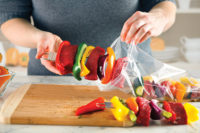
On a recent flight – admittedly it was international – I experienced one of those rare occasions when a complimentary hot meal was served in coach. And it was tasty. The person next to me was also impressed, until I revealed some trade secrets. I explained how the grill marks on the chicken breast, and most likely the carrots and zucchini, were applied by a machine designed solely to make marks … not cook the product. Further, that char-grilled flavor was probably injected into the meat by needles. She was shocked.
Applying cooking preparation flavors to meats — raw and fully cooked meats sold through foodservice outlets as well as directly to consumers via refrigerated or frozen prepared entrees — is a trend rapidly growing within the meat-processing industry. One of the most common flavors is that of the charcoal or wood-burning grill. Such a process is not only time-consuming and often unpredictable in terms of consistent heat, but also the cleanup is not one that most restaurants or processing facilities can afford. But, consumers crave outdoor grill flavor, even cruising at an altitude of 35,000 feet.
Commercial prepared-meat manufacturers want to offer consumers outdoor grill taste in the growing number of heat-and-eat meals and microwaveable sandwiches entering both the retail and foodservice channels. Unfortunately, these flavors are unattainable using indoor grilling systems. Thanks to an understanding of how these flavors are developed on the “real” outdoor grill, it is now possible to add them at the industrial level.
Scientists understand that desirable outdoor grill flavors develop when juices from the food drip down onto the hot coals or wood. The drippings get pyrolyzed by the heat, creating fumes that get absorbed by the food. By simulating this process under controlled conditions, that outdoor grill essence is turned into a commercial flavor. Flavorists can use their knowledge to take these flavors a step further by adding nuances such as mesquite, hickory or various fruit woods including apple, cherry and peach.
Meat processors and preparers have long turned to commercially prepared smoke flavor, as maintaining a traditional smokehouse is not realistic for most industrial food manufacturers. Today they are also using cooked flavors such as charred, roasted and toasted. Scientists have even been able to duplicate the flavors of cooking methods such as braising, caramelizing and sautéing.
Some flavor suppliers are adding ethnic notes, most notably peppers, to cooked flavors, providing meat processors with a one-stop flavoring system. Such innovative flavor fusions include “grilled blackberry chipotle,” which melds sweet blackberry with smoky chipotle. Whiskey flavor notes combine particularly well with char-grilled flavors intended for pork ribs.
There are some meat flavors designed to assist with mouthfeel more than flavor profile. For example, beef tallow flavor imparts the mouthfeel characteristics of a premium cut of meat. By adding it to low-cost, tough cuts, meat processors add value in terms of cost savings.
Most flavors are versatile enough to be used in any number of manufacturing processes, including breadings and batters, vacuum tumbling, injection, baking, retort and freezing. Specifically, when meat is sold raw for later cooking at home or in foodservice, grill flavors are typically added via a marinade, which is either applied by injection or tumbling. By adding these flavors directly to the product application, food manufacturers reduce equipment requirements, thus reducing capital costs. The flavors also save time, labor and material costs.
I tried to explain to my flying neighbor that from a health perspective, chicken breast made using grill flavors and mechanically applied grill marks eliminates the formation of carcinogens, which are produced when grilling meat over charcoal or wood. Unfortunately, like most non-food industry folks, this person just shook her head and started complaining about how over processed all our food has become. What did she expect, Rachel Ray grilling chicken in the airplane galley?





